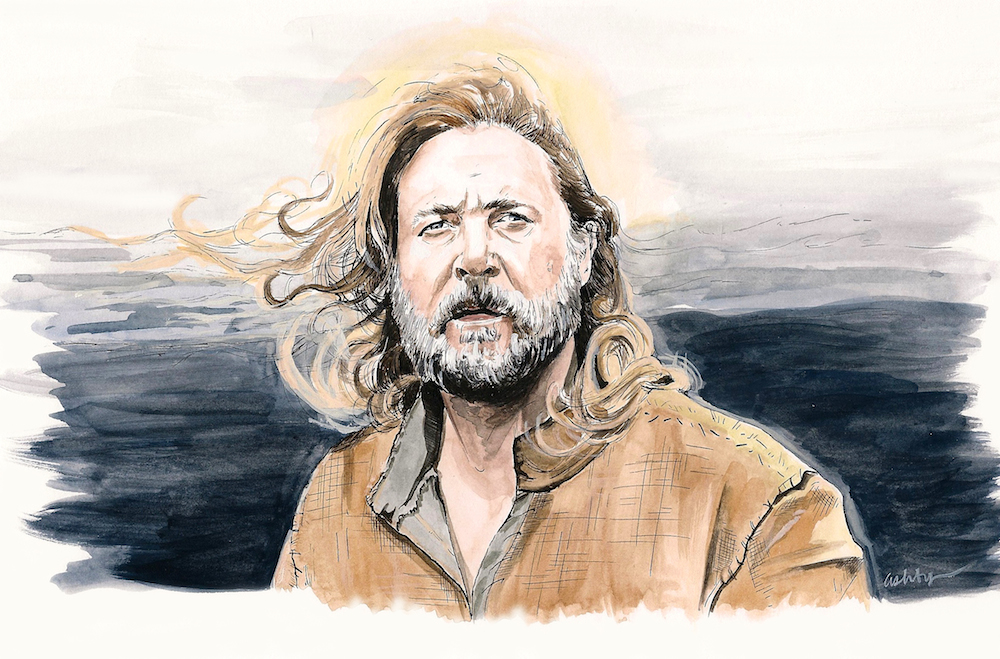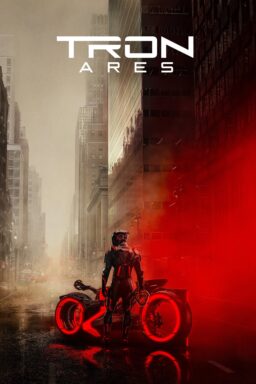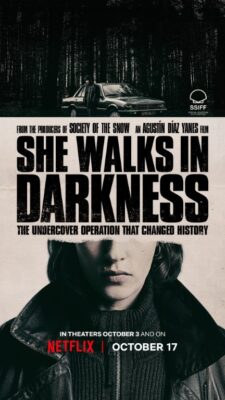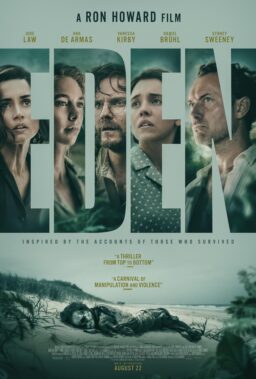We are pleased to feature an excerpt from the August 2016 edition of online magazine Bright Wall/Dark Room, which is focused on literary adaptations. In addition to the essay below by Lauren Wilford on Darren Aronofsky‘s “Noah,” the edition includes essays on “The Great Gatsby,” “Dune,” “The Hunger Games,” “The Road,” Stephen King/”Maximum Overdrive,” a piece on planned adaptations that never actually made it to the big screen and a Chaucer-esque lyrical retelling of the “Fast & Furious” films. The illustration above is by Brianna Ashby.
You can read previous excerpts from the magazine here. To subscribe to Bright Wall/Dark Room, or purchase a copy of their current issue, go here.
How do you adapt a sacred text?
It’s a question with a wider purview than it might first appear. Because every text is a sacred text to somebody. When a man says that an all-women “Ghostbusters” reboot is going to “ruin his childhood,” that’s an appeal to sanctity. It’s to say that the 1984 “Ghostbusters” is a text that can be desecrated, something that rather ought to be protected and reverenced.
Perhaps you don’t care about “Ghostbusters” (fair enough). But there are film adaptations you don’t care for, adaptations you hate, adaptations you believe violate the essential spirit of a text you love (“The Brothers Karamazov” [1958], “Wise Blood” [1979], “The Chronicles of Narnia: The Lion, The Witch, and The Wardrobe” [2005], are a few of mine). The contemporary movie news cycle subjects us to announcements of new adaptations all the time—news that can make us thrill and flinch at once. My heart leaps hearing that we’re getting miniseries adaptations of “Watership Down” and “The Handmaid’s Tale,” but that excitement is mingled with apprehension: What if they get it wrong?
The follow up question is, of course, so what if they do? What’s at stake in adaptation?
I think many children think of a film adaptation as a book that “turned into” a movie, a text that has transmogrified itself into images. But as we grow a little older, we start to compare the movie to the book—not so much comparing the movie we receive to the one we would have made, but rather comparing the experience of the movie to the experience we had while reading. “The book was better,” we say, wisely. As we grow into our critical faculties, we can start to conceive of movies as things that were made by groups of humans; we can condemn a film adaptation of a book as a series of bad calls. What you almost never hear is that a movie was as good as the book, or worthy of the book, or (heaven forbid) better than the book.
We are protective of our imaginative experience of a story. To read a work of fiction is to feel as if we are getting the real thing; hearing the story of a world as told by the creator of that world. It feels unmediated, a direct communion with the author, a vision passed seamlessly from the creator’s imagination to the reader’s. The analogous concept in religion is revelation, the idea that God sometimes chooses to communicate directly with humans, to reveal Godself to them. It is from revelation that most religions construct their doctrines. Novels, then, are revelation from the “God” of the fictional world. There’s a reason that fandoms use terms like “the powers that be,” “word of God,” and “canon” when talking about their beloved fiction properties. When a story moves us deeply, it can provoke a quasi-religious response. We evangelize, hoping to share the experience with others; we become invested in the legacy of the story, the preservation of its essence. This is especially true of the stories we came to love in childhood, the stories that shaped the way we see the world. A bad adaptation feels like someone telling the story wrong. It feels like betrayal—like blasphemy.
This, then, is how a movie could “ruin your childhood.” A new interpretation of a cherished story can send you reeling; it can pull up the roots that that story had extended into your worldview. It can make you ask yourself how and why that story meant so much to you in the first place.
Darren Aronofsky’s “Noah” ruined my childhood, and thank God.
***
The kind of people who hold to “the book was better” on principle are, perhaps, not the kind of people movies are for. To say that the book is always better than the movie is to subtly suggest several things: that words are better than pictures, that the abstract is better than the concrete, that spirit is better than matter. Written fiction, as opposed to dramatized fiction, has a kind of platonic purity about it; there are no bodies there, only ideas of bodies. “The book was better” as a dogma reminds me of Gnosticism, a collection of ancient religions that held the evils of the corruptible material world up against the eternal truths of the spiritual world. The dogma of “the book was better” suggests that we ought never to tangle up the miraculous vision of an author in the mess of embodied human drama; that so much gets lost in translation that it’s not worth it to try.
I don’t mean to say that the book is never better than the movie—it is, often, maybe even most of the time. But to champion adaptation is to champion the idea that stories are adaptable; that they can withstand the weight of interpretation, of translation, of imagination, of embodiment. A good adaptation opens up the possibilities for what a story can mean.
But for evangelical Christians, the Bible is the ultimate “the book was better.” American evangelical Christians for the most part hold the doctrine that the Bible is inerrant and infallible. The relationship between these concepts and Biblical literalism is complicated—one can claim inerrancy without literalism—but the main thing that a young evangelical absorbs from hearing these words is that the Bible is true, in a very high-stakes sense. The solemnity with which the Bible is treated makes the idea of adaptation seem fraught, if not dangerous.
But the interesting thing here is that most American evangelicals do come to the Bible through adaptation: at Sunday school. Nearly every evangelical I know learned their Bible stories from children’s Bibles, or from stories their Sunday school teachers told with the help of illustrated, moveable characters on felt boards (called “flannelgraphs” in Christian culture). I learned about Noah’s Ark this way—a charming tale about a man who gathered up all the animals in the world on a giant boat to weather a big storm. Children are big on animals, so the Noah story plays well to a child audience. But never is it framed as anything other than history. Children’s Bibles may paint their figures in bright colors and broad strokes, but this is only to make the stories go down easier—never to imply that they are just stories.
These children grow up, and if they are to stay in the conservative evangelical fold, their children’s Bible stories are going to need bolstering. Enter Ken Ham, director of the apologetics organization Answers in Genesis. His team, which brought us Kentucky’s Creation Museum in 2007, opened its second attraction in July: Ark Encounter. The $101-million Noah’s Ark theme park is meant to “equip visitors to understand the reality of the events that are recorded in the book of Genesis.” Ark Encounter promises to bring to life the “historical account recorded for us in the Bible,” positioning itself as a robust, adult response to the “beloved child’s tale of an overstuffed bathtub toy filled with all sorts of lovable creatures.” It’s supposed to be a Disney-style immersive experience, but it’s calculated to rouse your imagination only within the bounds of historicity. As you walk past the animatronic animals, you’re confronted with research and data; you’re meant to be awed, but more importantly convinced, reassured, certain. The stories you learned in Sunday school were all true—you just didn’t have all the facts to back them up yet. Ark Encounter is a gleaming symbol of the American evangelical apologetics machine: Everything we need to know about the history of the universe is here in this book, and the most important thing we can do is to make ourselves believe harder, and to arm ourselves with arguments against the unbelievers.
The moment Darren Aronofsky ruined my childhood comes a little more than halfway through “Noah.” Noah (Russell Crowe) and his family are finally shut into the ark, and the waters have risen above the earth. The light is low and the camera is centered in a close-up on Noah as we hear the screams of people clinging to the ark. We slowly dolly out from Noah, rocking with the water, as his children beg him to let the people on the ark: “There is room.” But Noah is resolute; no one can be saved. The camera pulls away from Noah, the screaming still faint, until we cut to a wide shot of the ark from the outside. The picture is Michelangelo’s Last Judgment by way of Bosch or Goya: Waves crashing on an obscene, roiling pile of human bodies atop the ark, wailing, crawling, a watery inferno of pure animal desperation.
Of course. Oh god, of course.
In that moment, I realized how little I had been permitted to imagine about the sacred stories I had been given. I had looked at dozens of illustrations of Noah’s ark—fully believing this was a historical event—and never imagined what a mass drowning might have looked like, felt like. And I felt horrified with myself, and with a version of faith, that had no place for imagining that horror—that had no place for realistically imagining anything at all. What could any of this possibly have meant to me if I “believed” it without having really pictured it?
***
My account might make it sound as if Aronofsky had set out to upset people, a cinematic bogeyman poised to pluck off vulnerable young Christians. That was certainly the rumor that spread through conservative media channels when “Noah” was about to come out—“brilliantly sinister anti-Christian filmmaking,” said Breitbart; “Atheist ‘Noah’ director brags film is least biblical Bible movie ever,” said The Washington Times. Evangelical social media was abuzz with warnings that Aronofsky had it in for Christianity.
But the fact is that Aronofsky wasn’t thinking about Christianity much at all when he made “Noah.” He wanted to tell a powerful story, and he found his inspiration in a story from Jewish scripture. It was never a Christian story to protect.
Once you understand “Noah” as a biblical adaptation in a Jewish mode, the whole thing lights up. Judaism has long had a tradition of interpretive storytelling about its scripture, known as midrash. Jewish theologians are not afraid to speculate, to fill in gaps, to imagine the lives of biblical characters outside the few words we are given about them. Robert Alter, a scholar of Hebrew literature, has argued in his book The Art of Biblical Narrative that the Tanakh’s “laconic” style invites us to fill in its gaps with our ethical imaginations:
Indeed, an essential aim of the innovative technique of fiction worked out by the ancient Hebrew writers was to produce a certain indeterminacy of meaning, especially in regard to motive, moral character, and psychology. […] The implicit theology of the Hebrew Bible dictates a complex moral and psychological realism in biblical narrative because God’s purposes are always entrammeled in history, dependent on the acts of individual men and women for their continuing realization. To scrutinize biblical personages as fictional characters is to see them more sharply in the multifaceted, contradictory aspects of their human individuality, which is the biblical God’s chosen medium for His experiment with Israel and history.
Most Jewish theologians have no problem envisioning a biblical “hero” like Noah as a complex character, and they have no problem thinking of many of the Tanakh’s stories as having mythical properties—especially the oldest stories, like the creation, the fall, and the flood. “Young Earth creationism” is largely a 20th century Christian invention. “Noah” is Darren Aronofsky’s midrash. In an interview with the Atlantic, Aronofsky described how he wanted to explore the idea of righteousness: “A balance between justice and mercy.” And he went on to articulate his frustration with the entire debate about the literal truth of the text: We don’t get caught up in whether Icarus really could have flown with wings made of feathers and wax; we understand that it’s a story about hubris and loss. (Aronofsky does go on to confirm his belief that much of the Tanakh recounts history, but that these early chapters reside in the realm of the mythical).
That Aronofsky’s imagination is unbounded by dogma makes it possible for him to dig into the darkness latent in the story—the childhood-ruining part—but it also allows him to approach the text with creativity, generosity, and a redemptive spirit. Growing up evangelical, the hermeneutic I had been given sounded like this: “This text is literally true. This text is inerrant. Do whatever research and soul-searching you need to do to make yourself believe this.” Aronofsky’s midrashic approach is to look at the text and say, “What might it feel like to be a human inside this story? How can I illuminate this text so that it feels real to the contemporary viewer—not literally true, but thematically rich and human? What does this have to say to us?”
From its first seconds, “Noah” ushers us into the world of myth. Jews and Christians use the word “antediluvian” when talking about the world before the biblical flood, and there is a traditional understanding that the world was somehow different then—a literal reading of Genesis would have us believe that in the antediluvian world, people lived to be hundreds of years old, and there was a layer of water around the world, and there had never been a rainbow yet. “Noah” situates itself in this strange time before time. Aronofsky chose to shoot much of the film in Iceland in order to give us pictures of a kind of primeval dystopia, replete with forests and imposing mountains but interrupted by tundras and scorched earth. In the film, Noah and his family are nomads, and when they have to make a journey, we see a little tribe traversing a world that feels vast and unknowable, like it might extend outward endlessly.
“In the beginning.” That’s how Genesis starts, and it’s how “Noah” starts too, a kind of ancient “once upon a time.” It readies us to hear a story from oral tradition, as if we were seated around a fire, listening to the most skilled orator in the tribe tell a version of a story we’ve heard many times before. In “Noah,” the characters all believe in God, but they all call God “The Creator,” one of the many savvy scriptwriting moves that help distance Noah from the familiar Bible story. The film begins with a montage of the earliest Jewish stories—the creation of the earth, the temptation of Adam and Eve, Cain’s murder of Abel—presented in silhouette against a backdrop of stars. The Noah story is to be one constellation in a galaxy of myths about the world’s origins.
Noah’s ark is a story of God’s judgment—one of the aspects of Judaism and Christianity least accessible to a contemporary audience. But Aronofsky manages to create pictures that reveal a humanity worth judging. In some ways, Noah is a little like “Mad Max: Fury Road“ set thousands of years earlier: It’s a picture of a world sucked dry, a “green place” made into a barren hellscape by human greed and violence. “Noah'”s images of evil are images of violent consumption; burning earth, cooking flesh, a live dog ripped to pieces.
There is a sequence about halfway through the film that manages to visually condense all of evolution into the Biblical origin story, with Noah’s voice laid over a series of partially animated stop-motion photographs. We advance from the big bang into the formation of galaxies; we see rivers carving mountains; we follow creatures developing out of primordial soup into fish and lizards and mammals. We see a hand reach out to grab the forbidden fruit, and the flesh of the fruit beats like a human heart. Cain kills Abel in silhouette against a sky streaked red, and we see a stop-motion set of men striking out with weapons, and then another set of men falling, stricken.
It’s a truly stunning piece of filmmaking. In the space of three minutes, the film collapsed and expanded my understanding of the Biblical origin story; it blew up the house and built it back up. In “Mad Max: Fury Road,” one of the wives asks, “Who killed the world?” In “Noah,” Noah answers: “We broke the world. We did this.” Growing up Evangelical, it was all too easy to associate the idea of a world in need of cleansing or judgment with groups like the Westboro Baptist Church—the kind of people who thought we were damning ourselves with sex and rock & roll. The stark, elemental violence of Noah reminded me that there are forces in the world that truly frighten and anger me, things capable of making me feel like the apocalypse is near. The desire for “justice rolling down like waters” is a human desire, not something social conservatives invented.
Noah in “Noah” is a character driven by this desire. He receives a vision (in the form of a dream that he does his best to interpret) that the world will be judged and cleansed, and does his best to be the man to steward creation through this judgment. But he takes his commitment to judgment too far, at the expense of humanity—at the expense of mercy. Aronofsky (and co-writer Ari Handel) craft a fictional narrative around the justice/mercy tension that animates nearly all of Jewish scripture. They make Noah into a character we can recognize and, implicitly, they also make the Jewish God into a character we can recognize. It doesn’t sit right, abstractly, that a good God would make the world and decide to destroy it. But it does make sense intuitively, emotionally, that if you made something beautiful and entrusted people to care for it, and then saw those people routinely neglecting it, discarding it, destroying it—that might make you want to wipe the whole thing out and start again. And that you might find that you had taken things too far.
My childhood faith is something I recognize less and less all the time. But “Noah” is a biblical epic grounded in recognizable human feeling, and it’s shown me how a sacred story can be adapted—re-presented—to speak to a contemporary audience.
As a child, I used to think that everyone who had read a given book had had the same experience, that the book contained within it an imaginary film reel that played the same on everyone’s brain-projector. I thought that the Bible contained a set of truths you could mainline. But I’ve come to believe that every act of reading is an act of adaptation. Every narrative sentence contains pictures that the reader must paint for herself. To close off a story to creative adaptation is really to close off a story to imagination—and thereby to make that story impenetrable, inhuman. When filmmakers adapt a story into a film, they give us a vision of that story; action, color, rhythm, bodies, feeling. If our stories—and our religious stories—are to survive, they must prove themselves expansive and resilient enough to bear retellings and reimaginings.
Good adaptations allow us to see things we couldn’t imagine the first time. But perhaps the best adaptations are the kind that breathe life back into a text that might have suffocated otherwise. My faith can’t survive as a set of stories too sacred to fully imagine. If I’m going to carry my sacred texts into my adult life, I’m going to have to adapt. Noah has provided me a remarkable model for how to go about that creative work—work I imagine I’ll be doing for the rest of my life.











